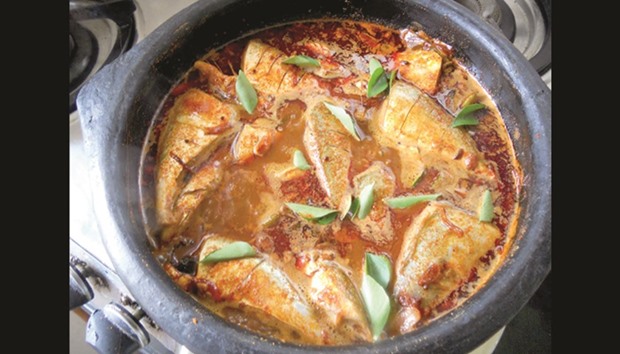Every Indian state is unique in itself with its own set of culture, food and other practices. One such diversified place is Goa, which has always secured its place as the seafood capital of India.
Rice and fish is a staple food here – king fish is eaten in abundance along with other local fishes. It is famous for its beautiful beaches and abundance of fresh seafood freshly grilled as per order. Another aspect of Goan cuisine is its rich, spicy and flavourful curries. One such curry is the Goan fish curry which is a speciality from the region and is unique in its preparation and taste.
Below, I explain the use and importance of the various ingredients and methods used in the making of the Goan fish curry and which are responsible for its special and unique taste.
Fish: the most important factor in the fate of any fish curry preparation is the fish and its quality. Firm and sweet fleshed fishes like king fish, halibut or pomfre, make a great choice for this fish curry. Some people call for frying the fish before they simmer it in the curry but I insist on simmering the raw fish in the curry so that the fish imparts its flavour to it.
The Spice blend: the next aspect of this robust fish delicacy is the spice blend. It is important to roast the spices first. Then make a paste of the spices and prepare this paste over slow flame so that the masala is cooked properly. The final curry should have a spicy, sweet and tangy blend along with the creamy texture of the coconut milk. Kashmiri chilli gives this curry a beautiful orange and yellow pink colour without making it curry too hot to eat.
Coconut: Every coastal curry has one very common ingredient – the coconut. This curry uses coconut in two forms: fresh grated and coconut milk. Coconut somewhat balances out the spiciness, pungency and makes the curry more subtle, rich, creamy and smooth. As always is the case, locally available ingredients are always used in majority of local dishes due to their easy availability and lower costs.
The sour element: The next aspect of any delicious fish curry is sourness. Many recipes call for tamarind and vinegar but I prefer kokum and vinegar. The kokum is more subtle and has more depth to its taste, as compared to tamarind. I also add some sugar to balance out the astringency and make it more flavourful.
Goan Fish Curry
Ingredients
Fish fillet 600 gm
Lemon juice 1 tbsp
Cumin seeds 1 tbsp
Ginger paste 1 tbsp
Kokum ½ tbsp
Garlic paste 1 tbsp
Malt vinegar 2 tbsp
Red chili whole 6-8 nos
Fresh coconut ½ cup
Green chili paste ½ tsp
Coriander seeds ½ tsp
Oil 1 tbsp
Tomato, diced ½ cup
Salt to taste
Shallot 3-4 no
Mustard seeds ½ tsp
Coconut milk 150 ml
For garnish
Curry leaves few sprigs
Method
Wash and trim the fish fillet, pat dry and marinate with salt and lemon juice and keep aside.
To make the masala, toast the spices on a cast iron pan until you get the aroma of the spices, remove on table top and allow to cool down.
Grind to a powder in a food processor and then blend in the remaining ingredients, except for the mustard seeds and coconut milk.
Heat oil in a heavy bottom pan over medium heat and add the fine chopped shallots, and mustard seeds, stir in the prepared masala mix.
Lower the flame when the masala begins to boil and let it simmer.
Once the masala becomes dry and most of the water has evaporated, dilute coconut milk with equal quantity of water and pour into the prepared masala, simmer for about five minutes.
Gradually add the cleaned and trimmed fish fillet to the simmering sauce.
Cook over low flame, without stirring the fish, otherwise the fish will break apart.
Adjust the seasoning and check if the fish is cooked, remove from flame and keep aside.
In a separate pan, heat oil, add mustard seeds, curry leaves and whole red chili for the tempering. over the prepared tempering on the fish curry, serve hot with steamed rice.
Notes:
1. Make sure that the spice paste is smooth and is not coarse in texture. A smoother paste will result in smoother gravy and will result in a more flavourful and robust Goan fish curry.
2. Use the Kashmiri red chillies as they will impart the right pungency and colour to the final dish.
3. You should chose a meaty and flaky fish for this dish to enjoy it more and do not stir the curry with the fish in it, just move/rotate the cooking pan so that the fish stirs on its own without breaking apart.

Goan Fish Curry.


